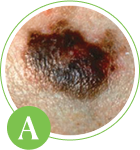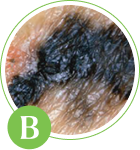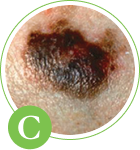Full-Body Skin Exam
During a full-body skin exam, your dermatologist will inspect every part of your body from your head to toes, paying particular attention to areas that tend to be exposed to harmful, cancer-causing UV radiation from the sun.
What We Look for During a Skin Exam
Detecting skin cancer early is often the top priority during a full-body skin exam. Skin cancer is one of the most common forms of cancer in the United States, but treatment is extremely effective if the cancer is caught early. Therefore, our dermatologists will look for new moles, growths, or discoloration and monitor existing moles for any changes.
What Does Skin Cancer Look Like?
Talk to your dermatologist immediately if any of your moles or pigmented spots exhibit any of the following ABCDEs of melanoma:

A is for Asymmetry:
One half of the spot is unlike the other half.

B is for Border:
The spot has an irregular, scalloped or poorly defined border.

C is for Color:
The spot has varying colors, including tan, brown, black, white, red or blue.

D is for Diameter:
Melanomas are usually about the size of a pencil eraser ( 6 millimeters) when diagnosed.

E is for Evolving:
The spot changes in size, shape or color.

A is for Asymmetry:
One half of the spot is unlike the other half.

B is for Border:
The spot has an irregular, scalloped or poorly defined border.

C is for Color:
The spot has varying colors, including tan, brown, black, white, red or blue.

D is for Diameter:
Melanomas are usually about the size of a pencil eraser ( 6 millimeters) when diagnosed.

E is for Evolving:
The spot changes in size, shape or color.
What Happens During a Skin Exam?
During the exam, your dermatologist will inspect your skin, looking for discoloration or lesions in each part of the body. You may be asked to wear a gown during the exam if necessary.
While performing the exam, your dermatologist will take note of any conditions they observe in your skin. Some conditions include:
- Actinic keratosis: These are precancerous lesions caused by sun damage to the skin that appear as rough patches or thick, scaly spots on different parts of the body with a sandpaper-like texture.
- Basal cell carcinoma: This is the most common form of cancer in the United States and usually appears as a pearly or waxy bump on areas of skin that receive frequent exposure to sunlight, such as the face and hands.
- Squamous cell carcinoma: These are rough growths or lesions that appear raised or flat depending on the severity. They can also appear scaly, crusty, red and inflamed, like a pimple.
- Melanoma: This is one of the most severe forms of skin cancer. It can appear as a new, unusual growth or stem from an existing mole.
- Sebaceous hyperplasia: This condition appears as unusually large skin glands that look like tiny bumps (sometimes called an “oil gland”). They are most often found near the corners of lips, eyes, nostrils and genitals.
Why Full-Body Skin Exams Require Dedicated Appointments
Nature of the Exam
During a full-body skin exam, your dermatologist will carefully examine all areas of your skin, including areas that are not regularly exposed to the sun. This level of thoroughness leaves no time to discuss or treat unrelated skin issues in the same visit.
Time for Education and Discussion
After the exam, your dermatologist will need time to educate you on your skin health, discuss their findings, and answer any relevant questions you may have. The educational component of these appointments cannot be skipped, as it helps ensure your skin remains healthy until your next annual skin exam.
How to Prepare for Your Appointment
To help make the most out of your appointment, you can prepare by:
- Performing a self-exam before the appointment and making a note of anything new or unusual that you notice
- Remove nail polish from your fingers and toes
- Bring makeup remover or plan not to wear makeup at all
- Prepare a list of any questions that you have about your skin, skin cancer, or other dermatological concerns
What Happens After Your Exam?
If your provider does not find anything suspicious during your skin exam, that’s great! They may schedule you for another appointment in one year. However, if they find something unusual or suspicious, they will take a biopsy to send for testing.
Our state-of-the-art skin pathology lab will process and analyze the sample to determine if it is cancerous or benign. Once the samples have been skillfully evaluated, they are electronically reported directly back to the provider.
With our rapid turnaround times and quality processing, patients are able to receive and understand their diagnosis as soon as possible.
If skin cancer is detected, your dermatology office will reach back out to you to schedule an appointment to discuss treatment options.
Request More Information
"*" indicates required fields
To request more information on our services, please fill out the form and a member of our staff will contact you.
If you are an existing patient looking to refill a prescription, pay a bill, access medical records, view lab results, or communicate with staff, please visit our patient portal for these services. You can also check out our patient portal overview page for additional information.